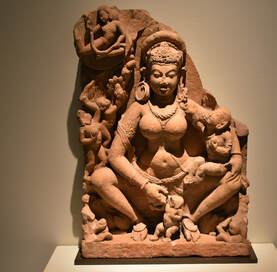
Today in MUS 5: Introduction to Western Music, a group will be presenting on Pauline Oliveros, and I’ll teach a small segment on Libby Larsen. Both composers had deep ties to the natural world, as was described in Denise Von Glahn’s book, “Music and the Skillful Listener: American Women Compose the Natural World.” I have been using this book as a secondary text in this class for years, and asked the Penn State library (which they did) acquire a digital copy so students could access it at no cost. Each year, I separate the students into groups based on the chapters on Amy Beach, Joan Tower, Louise Talma, Marion Bauer, Ellen Taaffe Zwillich, and Pauline Oliveros, and I cover Emily Doolittle and Libby Larsen separately. These women composers serve as counterpoint to the classical music history created in the primary text, which includes few women composers, and those in condensed manner. For instance, I explain to students that even though I begin this class with Hildegard of Bingen, because we begin with medieval musics, many music history texts don’t mention Hildegard's name. Despite her importance to the field. I hope a more counterpuntal approach, one that centers gender, awakens students to gendered hierarchies in classical music and the world.
I use Von Glahn’s chapter on Larsen to contextualize Larsen's work and address distinctive ecological challenges we face in the 21st Century. Libby Larson (b. 1950), who co-founded the American Composers Forum (which promotes diverse composers and collaborations) has long been linked to the University of Minnesota. Unlike other composers in the book, Larsen’s work emphasizes “extramusical intent” (p. 242) with clear political and ecological agendas.
Women composers have traditionally been connected to what Von Glahn calls small-nature subjects, such as ants and grasshoppers, home and gardens; and Larsen composes music inspired by these; but she also composes pieces inspired by big-nature, the atmosphere, moon, and the skies and sea. Larson defines nature as a life-embracing action. “For me nature is life force, life force, global and way beyond global … the physical forces that allow those who are imbued with it to recognize their state of being” (p. 243).
Larsen embraces the concept of Gaia, in contrast to the patriarchal church she grew up in. “Nature provided her with an ungendered place and limitless possibilities” (p. 252). The Gaia Hypothesis was put forth by biologists James Lovelock and Lynn Margulis in the 1970s. In this theory, the Earth is treated as a living entity, with self-regulated boundaries and, most importantly, life as people define living beings. “This new way of looking at global ecology and evolution differs from the classical picture of ecology as biological response to a menu of physical conditions.” Findings in research on mycorrhizal fungi, climate change, earth systems, self-organization of the biosphere, each deepen our understanding of Gaian science.
In class we listen to Larsen’s Womanly Song of God, which is based on Catholic poet Catherine de Vinck’s "Woman Singing," (p. 41) in the collection, God of a Thousand Names.
Larsen's program notes read:
“The music for The Womanly Song of God draws upon Western European trumpet tonguing syllables set to African drumming patterns to create drum circle/drumminbg ensemble feel for the chorus - a whirling and powerful force to support the spiritual energy of the text.
Poet Catherine DeVinck (b. 1923) describes her writing as "soaked in the theology of hope, that is, in the knowledge that death has no dominion, that light overcomes darkness, and that love is a divine power of transformation and renewal.”
And here are the lyrics:
I am the woman dancing the world alive:
Birds on my wrists
Sun-feathers in my hair
I leap through hoops of atoms;
Under my steps
Plants burst into bloom
Birches tremble in their silver
Can you not see the roundness of me:
Curve of the earth
Maternal arms of the sea?
I am the birthing woman
Kneeling by the river
Heaving, pushing forth a sacred body!
Round, round the wind
Spinning itself wild
Drawing great circles of music
Across the sky
Round the gourd full of seed
Round the moon in its ripeness
Round the door through which I come
Stooping into your house
I am a God of a thousand names:
Why cannot one of them be
Woman Singing?
Questions for students:
How does Larsen relate to the natural world?
Why do you think it is important that Larsen writes both reflective of small-nature and big-nature?
In what ways in nature a life force?
DS
Link to image, Mother Goddess, Madhya Pradesh or Rajasthan, India, 6th - 7th cents., National Museum of Korea, Seoul: upload.wikimedia.org/wikipedia/commons/f/f0/Mother_Goddess%2C_Madhya_Pradesh_or_Rajasthan%2C_India%2C_6th_-_7th_cents.%2C_National_Museum_of_Korea%2C_Seoul_%2840236606165%29.jpg
 RSS Feed
RSS Feed
